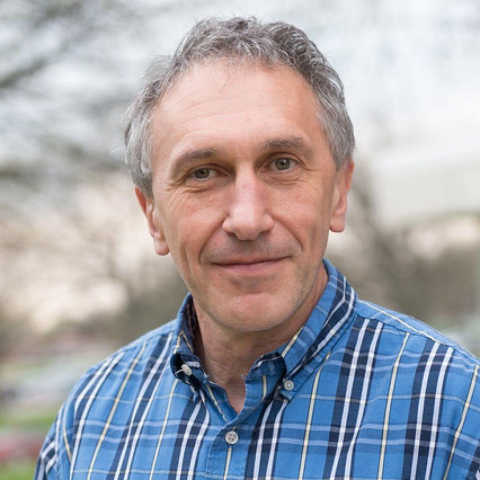Igor Aronson
Co-Director of the Center for Mathematics of Living and Mimetic Matter; Huck Chair Professor of Biomedical Engineering, Chemistry and Mathematics

-
218 Hallowell
University Park, PA - isa12@psu.edu
- 814-867-6260
Huck Affiliations
Links
Most Recent Publications
Biomechanical modeling of spatiotemporal bacteria-phage competition
Andrés Valdez, Hui Sun, Howard Howie Weiss, Igor Aranson, 2025, Communications Physics
Durotaxis and extracellular matrix degradation promote the clustering of cancer cells
Mykhailo Potomkin, Oleg Kim, Yuliya Klymenko, Mark Alber, Igor S. Aranson, 2025, iScience
Vortex reversal is a precursor of confined bacterial turbulence
Daiki Nishiguchi, Sora Shiratani, Kazumasa A. Takeuchi, Igor S. Aranson, 2025, Proceedings of the National Academy of Sciences of the United States of America
Collective buoyancy-driven dynamics in swarming enzymatic nanomotors
Shuqin Chen, Xander Peetroons, Anna C. Bakenecker, Florencia Lezcano, Igor S. Aranson, Samuel Sánchez, 2024, Nature Communications
Bacteria Navigate Anisotropic Media using a Flagellar Tug-of-Oars
Ameya Prabhune, Andy Garcia-Cordillo, Igor Aronson, Thomas Powers, Nuris Figueroa-Morales, 2024, PRX Life on p. 9
The effect of repeat feeding on dengue virus transmission potential in Wolbachia-infected Aedes aegypti following extended egg quiescence
Meng-Jia Lau, Andres Valdez, Matthew J. Jones, Igor Aronson, Ary Hoffmann, Elizabeth A. McGraw, 2024, PLoS Neglected Tropical Diseases on p. 16
Spontaneous shock waves in pulse-stimulated flocks of Quincke rollers
Bo Zhang, Andreas Glatz, Igor S. Aranson, Alexey Snezhko, 2023, Nature Communications
Ultrasound Manipulation and Extrusion of Active Nanorods
Leonardo Dominguez Rubio, Matthew Collins, Ayusman Sen, Igor S. Aranson, 2023, Small
Viscoelasticity enhances collective motion of bacteria
Wentian Liao, Igor S. Aranson, 2023, PNAS Nexus
Programming motion of platinum microparticles: From linear to orbital
Angus Unruh, Alan Brooks, Igor Aranson, Ayusman Sen, 2023, ACS Applied Engineering Materials on p. 1126-1133
Most-Cited Papers
The 2020 motile active matter roadmap
Gerhard Gompper, Roland G. Winkler, Thomas Speck, Alexandre Solon, Cesare Nardini, Fernando Peruani, Hartmut Löwen, Ramin Golestanian, U. Benjamin Kaupp, Luis Alvarez, Thomas Ki rboe, Eric Lauga, Wilson C.K. Poon, Antonio Desimone, Santiago Muiños-Landin, Alexander Fischer, Nicola A. Söker, Frank Cichos, Raymond Kapral, Pierre Gaspard, Marisol Ripoll, Francesc Sagues, Amin Doostmohammadi, Julia M. Yeomans, Igor S. Aranson, Clemens Bechinger, Holger Stark, Charlotte K. Hemelrijk, Fran ois J. Nedelec, Trinish Sarkar, Thibault Aryaksama, Mathilde Lacroix, Guillaume Duclos, Victor Yashunsky, Pascal Silberzan, Marino Arroyo, Sohan Kale, 2020, Journal of Physics Condensed Matter
Flocking ferromagnetic colloids
Andreas Kaiser, Alexey Snezhko, Igor S. Aranson, 2017, Science advances on p. e1601469
Active turbulence in a gas of self-assembled spinners
Gašper Kokot, Shibananda Das, Roland G. Winkler, Gerhard Gompper, Igor S. Aranson, Alexey Snezhko, 2017, Proceedings of the National Academy of Sciences of the United States of America on p. 12870-12875
Topological defects in a living nematic ensnare swimming bacteria
Mikhail M. Genkin, Andrey Sokolov, Oleg D. Lavrentovich, Igor S. Aranson, 2017, Physical Review X on p. 011029
Collisions of deformable cells lead to collective migration
Jakob Löber, Falko Ziebert, Igor S. Aranson, 2015, Scientific Reports
Tuning antimicrobial properties of biomimetic nanopatterned surfaces
Martyna Michalska, Francesca Gambacorta, Ralu Divan, Igor S. Aranson, Andrey Sokolov, Philippe Noirot, Philip D. Laible, 2018, Nanoscale on p. 6639-6650
Collective motion of self-propelled particles with memory
Ken H. Nagai, Yutaka Sumino, Raul Montagne, Igor S. Aranson, Hugues Chaté, 2015, Physical Review Letters on p. 168001
Engineering bacterial vortex lattice via direct laser lithography
Daiki Nishiguchi, Igor S. Aranson, Alexey Snezhko, Andrey Sokolov, 2018, Nature Communications
Computational approaches to substrate-based cell motility
Falko Ziebert, Igor S. Aranson, 2016, npj Computational Materials
Bacterial active matter
Igor S. Aranson, 2022, Reports on Progress in Physics
News Articles Featuring Igor Aronson
Nov 22, 2024
Q&A: How does ‘collective intelligence’ emerge among tiny robots?
Researcher awarded $1.05M to study the emergence of collective intelligence among simple microrobots.
Full Article
Aug 15, 2024
Penn State awards five new seed grants to support inter-institutional research
Five new research collaborations between Penn State and minority-serving institutions selected to receive seed funding via the Inter-Institutional Partnerships for Diversifying Research program.
Full Article
Dec 07, 2023
Spinning up control: Propeller shape helps direct nanoparticles, researchers say
An international team of researchers has developed an approach to rein in the synthetic self-propelled nanoparticles
Full Article
Dec 05, 2023
Bacteria's mucus maneuvers: Study reveals how snot facilitates infection
New study shows thicker mucus supercharges bacteria’s ability to self-organize into swarms to spread infection
Full Article
Jun 15, 2023
Penn State researchers use ultrasound to control orientation of small particles
Acoustic waves may be able to control how particles sort themselves. While researchers have been able to separate particles based on their shape — for example, bacteria from other cells — for years, the ability to control their movement has remained a largely unsolved problem, until now.
Full Article
Dec 12, 2022
Model shows how intelligent-like behavior can emerge from non-living agents
From a distance, they looked like clouds of dust. Yet, the swarm of microrobots in author Michael Crichton’s bestseller “Prey” was self-organized.
Full Article
Nov 30, 2020
Biomedical engineers find active particles swim against the current
Researchers are beginning to understand the behavior of so-called “active” particles, which, if it can be controlled, has potential implications for engineered drug delivery systems and smart 3D printing, according to an interdisciplinary Penn State research team.
Full Article
Oct 30, 2019
Tiny swimming donuts deliver the goods
Bacteria and other swimming microorganisms evolved to thrive in challenging environments, and researchers struggle to mimic their unique abilities for biomedical technologies, but fabrication challenges created a manufacturing bottleneck. Microscopic, 3D-printed, tori — donuts — coated with nickel and platinum may bridge the gap between biological and synthetic swimmers, according to an international team of researchers.
Full Article